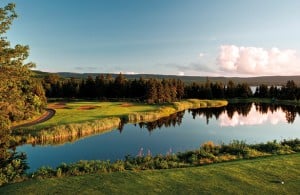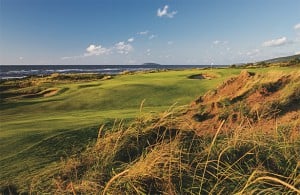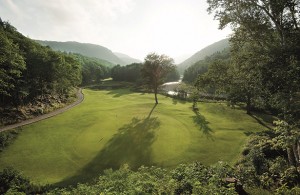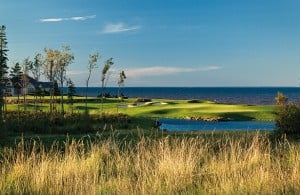Curiosity took me recently to a region of the world so distant from Australia that I had only previously associated it with the famous Titanic shipwreck, and icy winters, but never with golf. That is until I heard about Cabot Links in Nova Scotia.
Nova Scotia is one of the eastern maritime provinces of Canada, and the capital, Halifax, is where many victims of the Titanic are buried in city cemeteries. Halifax-based cable steamers had the grim task of sailing out into the Atlantic to recover what bodies could be found when the White Star liner sank in 1912 after striking an iceberg.
Canada is the second largest country in the world in terms of land mass. If you choose to travel across its entire width, from Halifax to Vancouver, it is a journey of more than 6,000 kilometres. You can take the train the entire way – three separate trains in fact, as you have to change in Montreal and Toronto – and the quickest route is five days. This is all by way of saying that Nova Scotia is a world apart from the Canadian Rockies.
Cabot Links was opened for play three years ago, but its close association with Mike Keiser, the owner of Bandon Dunes in Oregon, has brought it the kind of immediate fame that remote destinations can only dream about. So many golf writers have already made the trip to Cabot Links that it no longer needs to advertise its presence.
It was in the late 19th century that golfers first made pilgrimages to Scotland to play the great links associated with the origins of the game. Today, golfers from every corner of the world still make these expeditions to St Andrews and Dornoch in Scotland, Ballybunion and Royal County Down in Ireland. But other international destinations have become the pursuit of restless global travellers with a passion for natural linksland. Importantly, though, it should be remote, far from populated centres, and have an unspoiled aura. The Bandon Dunes resort has become one such place of pilgrimage, Tasmania’s Barnbougle Dunes another, and Cabot Links is the latest to put down a marker.
Having already been to Bandon Dunes, it was ostensibly to see Cabot Links that I made plans to travel to Nova Scotia. Yet further research about where else to play in the region revealed one of the golfing treasures of the world, a course whose sublime beauty and charm the Canadians have kept largely to themselves for almost 75 years. That course is the Highlands Links, not far from Cabot Links. Both are on Cape Breton Island, and the coast-to-coast drive from one to the other, called the Cabot Trail, traverses the rugged hills of a national park.
Cape Breton is an island only in the geographical sense that it is separated by water from the mainland. However, the Canso Causeway is more like a moat. You cross over it to the northern half of Nova Scotia in less than a minute. Cape Breton, as the name suggests, was originally settled by the French, and there remains a large Acadian population, plus Scottish and Irish descendants, who lend a lively character to what I found to be the most beguiling part of Nova Scotia in terms of scenery and golf.

Golf is a popular sport in Canada. There are more than 2,000 courses. Nova Scotia is no exception. Ice hockey takes precedence in winter and golf in summer. Canadians are passionate about both. The game is promoted and encouraged from government level down, and Canada went through a golf course construction boom from the early 1990s onwards. We were there in mid-June, a quiet period, but the courses were nonetheless consistently busy. Not altogether surprising when you consider Canadians have a distinct six-month season in which to play.
Canada had a string of designers who made names for themselves during the ‘90s, including the likes of Graham Cooke, Thomas McBroom, Doug Carrick, Rod Whitman, Robbie Robinson and Les Furber. I hadn’t previously heard of any of them. They were building scores of pay-and-play facilities in which provincial and city governments had invested. The boom is over, though, and governments are now trying to sell these assets to private owners, as golf is politically being seen today as something of a “fat cat” sport.
In these recessionary times, Cabot Links would never have happened without the financial muscle of Keiser, who sees it as a Bandon Dunes of the east coast that will attract wealthy Americans, being much closer to New York. The original developer was Ben Cowan-Dewar, a Canadian golf-travel specialist, who persuaded Keiser to invest in the project. Now they have a second course on the go, Cabot Cliffs, being designed by Ben Crenshaw and Bill Coore, which is on a more dramatic tract of shoreline. It will open in 2015.
The west coast of Cape Breton is rugged backwoods country, and Cabot Links is in the former coal mining town of Inverness (Nova Scotia does, after all, mean New Scotland). This previously depressed area is now facing up to an influx of golfing tourists in the summer months. The “resort” (48 comfortable lodge rooms overlooking the links, plus a pub and smart restaurant) is in the main street of this small town, different to Bandon Dunes, which is well away from human habitation.
This is links golf that is faithful to Scotland, flat against the ocean, something you just don’t see in North America, which is why it has been so widely acclaimed. But even if you placed Cabot Links in the UK or Ireland, it would still stand out from the herd, with its distinctive classic properties and panoramic ocean views that rival Turnberry. At first glance it looks intimidating, with fierce-looking bunkers, shifting terrain, and sloping greens. But after measuring it up you realise this is a relatively gentle links, one you can enjoy without fear of having your game put under severe strain. The fairways are generously wide, and the deep bunkers avoidable.
We had caddies for our first round (mine an experienced Scot, Alan Dear, had previously worked at Pine Valley) when we played with veteran head pro Joe Robinson, who left his post at Highlands Links when Cabot first opened. They all helped in building our confidence for when we were let out on our own the following day. The weather had a familiar Scottishness to it as well, being suitably dreich the first day, then comfortably warmer the next, without ever suggesting you needed to remove that pullover.
Interestingly, this was the only course we played in Canada where everyone walked. Most Canadians appear happier driving carts.

Cabot Links was designed by Rod Whitman, and he let the holes flow naturally over dunes land which had once been the site of mine shafts. He turns the course back for home at the par-4 11th, bordering the linksland and fishing boat harbour. There follows a wonderful run of holes along the shore, close to the beach and breakers, which is the equal of any links in the world. There’s a higher dune in the centre of the links, which has three teeing grounds for various holes (including a short downhill par 3 facing the ocean), and provides not only all-round views but the presence of a friendly staff member offering free bottles of water, advice and photo calls.
We were accompanied on our travels around Nova Scotia by local character Terry Burns, a veteran of the golf industry who promotes the region. Golf Coastal Canada is a website that shows the breadth of the game in Nova Scotia, Newfoundland, New Brunswick and Prince Edward Island, and volunteers like Terry do much to boost the game’s endurance. Terry kept us entertained and proved a lively and competitive companion on the courses he had chosen for us to play. After Cabot Links he was keen to show off one he had himself built and managed, Le Portage, further north along the trail at the Acadian fishing town of Cheticamp.
We played mostly at resort-type facilities geared up for visitors; Le Portage is a club which had been funded by the local community, and it had a superb, wooded 18 holes in the kind of setting I had pictured in my mind as atypical Canadian, the mountain and forest backdrop of the Cape Breton Highlands National Park.
Terry introduced us to lobsters at a restaurant in Pleasant Bay, near the northern tip of Nova Scotia. They were on a lunch special for $20. Lobster fishing provides a living for thousands of locals, and as a rite of summer everyone seemed to be literally having a crack at this delicacy wherever we ate. The entire red lobster arrives on your plate along with a claw-cracker to bust it open. Diners who tackle the lobster more wholeheartedly use a bib, similar to one I last wore as a baby, for protection from squirting crustacean juice. Eating a lobster requires patience, as meat is hidden in the tiniest crevices of the carapace. Terry went on uncovering more and more of it, long after we were done.
Eating out was the most expensive part of being in Canada. I was told that even Americans find it excessive. A meal of chowder, fish and wine for two at the Cabot Links restaurant left us with a bill for around $200. Pub food was always the cheapest option, burgers or fish & chips. A steak in a quality restaurant was about $50.

We were close to the town of Ingonish and, for me, the highlight of the trip, Highlands Links, on the craggy shoreline of Cape Breton’s east coast. I had first viewed it from home on one of the course webcams, when the snow was visibly melting on the fairways after a long winter. It is remarkable that a course of this stature came to be in a place as remote as this, and that work on it began in a year when World War Two was underway on the other side of the Atlantic. It was finished in 1941.
Its architect, Stanley Thompson, was a pioneering soul, as well as being a talented designer regarded as Canada’s equivalent of Alister Mackenzie or Donald Ross. Among his great works are courses in the Rockies, while St George’s G&CC in Toronto (1929) is consistently ranked the country’s No.1. Thompson has a link to 178 courses over a period of 40 years (1912-1952), 144 of them in Canada, and many believe Highlands Links to be his masterpiece, although its ranking has slipped following a recent phase of neglect by its owners, Parks Canada.
Thanks to restoration work by Ian Andrew, an expert on Thompson brought in by operations manager Graham Hudson, who loves the course, and the eradication of numerous spruce trees which had blocked views of the ocean and stifled the growth of grass, Highlands Links is coming back into its own. It is a spectacular creation, and isn’t easy to describe. The era in which it was built meant that the excavating work was done with one piece of machinery, a steam shovel, which accounts for its quirkiness and unique looks.
The course meanders away from the clubhouse along the shoreline for the opening six holes, before disappearing into a dense hilly forest which is home to moose and bears. Trees define the fairways, and the holes weave in an undulating fashion here and there, across the gently flowing Clyburn River, before returning to civilisation at the 13th green. There’s a beautiful river walk of about 400 metres from the 12th to 13th. Hudson explained that Thompson had included it so that golfers could commune with nature and appreciate the beauty of their surroundings. “In early days this was a popular spot for golfers to take a break. Staff from the hotel would bring them food and drink, and they would relax on the river bank,” he said.
There is hardly a level lie on the course. The first fairway resembles a rumpled carpet, and some of the early greens are outrageous with their slopes and swales. The course opens with two difficult par 4s, and then offers a long stretch of par 3s, short par 4s, and tricky par 5s. Several are listed in the Top 500 Golf Holes of the World. It’s the finish that distinguishes the course as a classic, though. From the long par-3 12th onwards you’re constantly defending par. The most difficult hole, and most ingenious in design concept, is the wondrous par-5 15th, which rolls out of the forest over a steeply undulating fairway down towards another ocean view.
Hudson pointed out that each hole has a fascinatingly descriptive Scottish name, thought out by Thompson. Killiecrankie, the par-5 seventh, resembles the famous pass, while the green at Mucklemouth Meg has a “yawning opening like the loud mouthed woman in Scottish lore.”
I liked the terms “Heich O’Fash” (heap of trouble), “Tattie Bogle” and “Sair Fecht” (hard work), and the course guide explains every one.
Highlands Links was built in tandem with a luxurious hotel called the Keltic Lodge, built in the grand old tradition of North American resorts where residents settled in for weeks at a time to unwind and relax. It is scenically situated on a narrow headland stretching out into the ocean. On either side you look down on peaceful looking inlets, bays and beaches. Ingonish is 400 kilometres from Halifax Airport, the last couple of hours along a winding road over the mountains, yet it remains a popular destination for summer holidaymakers
ONE of the prettiest spots for a break in Cape Breton is the bustling tourist town of Baddeck, on the shore of Bras d’Or Lake, where sailing takes place. It was home for most of his lifetime to one of the greatest inventors of the modern age, Alexander Graham Bell, a Scot who moved to Canada for health reasons. The impressive museum in town has a replica of his Silver Dart aircraft which completed the first controlled power flight in Canada over the ice-covered lake in 1909.
And on the hill overlooking the town is the Bell Bay Golf Club, with an attractive modern layout. The chef at the Inverary Hotel, where we stayed the night, provided the best culinary experience we had in Canada, with an array of tasty dishes.
One of the smartest new resorts in Canada is Fox Harb’r on the Northumberland Strait between Nova Scotia and PEI. The personal fiefdom of billionaire businessman Ron Joyce, who established the Tim Horton fast food franchise, it has an exclusivity about it that is appealing to the rich and famous. The entrance gates are on a quiet country road, but many of the guests prefer to arrive by air. Tiger Woods played a charity event there in 2009, and his jet was able to land an 8-iron away from the clubhouse. Joyce built an airport for his fleet of aircraft adjoining magnificently-appointed luxury lodges, and the runway is so close to the ninth fairway that one of his pilots misjudged the approach in swirling winds and crash-landed with Joyce on board.

The Graham Cooke design is a beauty, an inland front nine complemented by a challenging and scenic back nine on the shorefront more exposed to ocean breezes. Few can afford the $225 green fee, so we basically had the course to ourselves.
Halifax hosted a Web.com Tour event in July, at Ashburn Golf Club, and we played the previous week at another city venue, Glen Arbour, which held the 2005 Canadian Women’s Open on the US LPGA Tour. Built within an upmarket estate where the housing never intruded, it was a challenging and hilly layout with slick greens which was easy to like. Halifax itself is a delightful clean-looking city, with a strong nautical feel. It has a unique inland basin serving as a harbour, ships entering through a narrow passageway under two high road bridges.
On our last golfing day we drove over to the other coast, to the Digby Pines Resort on the Bay of Fundy. Digby is famous for its scallops, having a busy harbour, and a ferry service to Saint John in New Brunswick. The resort hotel has been around for more than a century, and has old world charms and comforts which make you yearn for a few days of extra relaxation.
Nova Scotia is a place where the word “stress” doesn’t seem to exist. More interesting for us was that the Pines resort course is another Stanley Thompson design. In its parkland setting it lacked strong characteristics, yet like all the courses in the region it provided much enjoyment in its playability and conditioning.
Coming all this way had been fun.
GOLF IN NOVA SCOTIA
Two courses in World Top 100; Five in ScoreGolf’s 59 best Canadian public courses.
- 5 stars – Cabot Links
Inverness, Cape Breton
Designer: Rod Whitman
$150 green fee and $75 second round (lodge accommodation starts at $245 a night for a double room);
cabotlinks.com
- 5 stars – Highlands Links
Ingonish, Cape Breton
Designer: Stanley Thompson
$120 and $60 twilight rate (golf packages with Keltic Lodge)
highlandslinksgolf.com
- 4 stars – Fox Harb’r Resort
Northumberland Strait
Designer: Graham Cooke
$225 (golf packages include accommodation)
foxharbr.com
- 4 stars – Bell Bay
Baddeck, Cape Breton
Designer: Thomas McBroom $90;
bellbaygolfclub.com
- 4 stars – Glen Arbour
Hammond Plains, Halifax
Designer: Graham Cooke
$60-$90 weekdays;
glenarbour.com
- 4 stars – Digby Pines Resort
Digby, Bay of Fundy
Designer: Stanley Thompson
$85 and $55 twilight
(accommodation and golf packages start at $122)
digbypines.ca
- 3 stars – Le Portage
Cheticamp, Cape Breton
Designer: Robert & David Moote
$70 and $50 twilight;
leportagegolfclub.com
[all prices approximates only]




